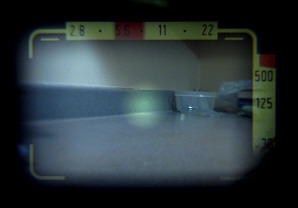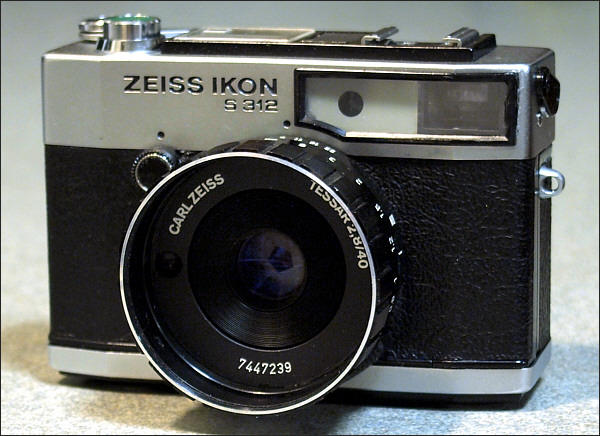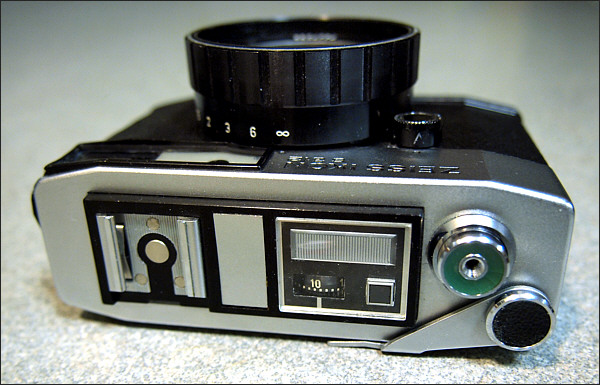Farewell, Zeiss Ikon

One of the hallmarks of Zeiss Ikon was that its many cameras had actual names. Admittedly, some weren't that creative, such as Movikon for a movie camera, and the Ikonta, which was a play on the company's name. Then there was the Contessa.
An elegant name for a line of cameras that paid homage to one of the camera maker's predecessor companies, Contessa-Nettel. By the way, there was a Super Nettel camera in the Zeiss Ikon lineup.
The Contessa camera didn't grace a Zeiss Ikon camera until well after the post-war period with the folding Contessa. Zeiss Ikon replaced that with a series of non-folding Contessa models, which also includes the Contessamat and Contessamatic..
The last camera to carry the Contessa name was the S 310, a scale-focus model that is a simper version of the camera that you see above. For one reason or another, Zeiss Ikon dropped the Contessa name for the S 312. As far as I can tell, this is just one of two cameras to be sold without a model name, the other being the SLR Zeiss Ikon SL 706, which was a slightly warmed-over Voigtlander Icarex.
The S 312 is notable for being the last rangefinder built by Zeiss Ikon. It was released in 1971, just a year before the demise of Zeiss Ikon. I don't know why it wasn't called the Contessa S 312. Perhaps, it was supposed to carry that name. In any case, it lacks a name and features only a model number.
As I mentioned, the S 312 is built on the same frame as the Contessa S 310. And it should also be mentioned that there was a comparable Voigtlander model, the VF 101. By this time, Zeiss Ikon had taken full control over Voigtlander, and you will find cameras and accessories from this period marked Zeiss Ikon/Voigtlander. The VF 101 has a slightly different top deck and was available in satin chrome or all black. The S 310 and S 312 were available only in satin chrome, as far as I can tell.
As it turns out, the S 312 is a sophisticated camera. For starters, it has a Prontor Electronic leaf shutter with speeds running from four seconds to 1/500. There is a hot shoe, as well as a flash-synchronization port. The shutter release button includes threads for a cable release. Apertures run from 2.8 to 22, and the viewfinder adjusts for horizontal parallax as you focus the lens.
The camera is graced with an f/2.8 40mm Tessar. It uses front-cell focusing, as does the S 310.
There is a frame counter and film-movement indicator that work in tandem. If you don't load the film correctly, the indicator doesn't move. Nor does the frame counter.
Zeiss Ikon includes an on-off switch for the camera's CdS (cadmium sulfide) meter. It doubles as a switch that changes the shutter from automatic to flash only with a speed of 1/30.
Next to the auto-resetting frame counter is a small button that checks the battery and also turns on a small light on the top deck. However, in real world use, at night the light is too bright and glares directly into the user's eye, making it difficult to see the frame number. The way to overcome this is to place your thumb over the small light. That makes the frame number easier to see.
The rewind crank is located on the bottom of the camera. There is no rewind button or switch. You simply pull out the lever and turn in the direction indicated by the red arrow to rewind the film.
Completing the tour of the base of the camera, there is a twist-type tab release for removing the back. Next to that is the knurled battery cap.
The camera is powered by four 1.5-volt type 625 cells. Normally, these are 1.35 volts, although the holder is marked 1.5 volts. What is interesting is that this is really two sets of two batteries, which provide 3 volts. The Prontor Electronic probably required more current, so that is why Zeiss Ikon opted for four batteries to provide 3 volts. The manual for the S 310 notes that in an emergency, the photographer could use two batteries.
It is very simple to make some alterations and replace the four batteries with a single 3-volt type 123 lithium cell. The advantage is that the 123 battery lasts a long time and provides plenty of current for the shutter.
Using the camera
Start by twisting the small tab on the base of the camera so that you can remove the back.
The hinged pressure plate reminds me of the one on the Rollei 35. Both keep the film very flat. Swing the pressure plate down, and lay the film leader across the takeup drum. There are some teeth that grab the film sprockets, and you can feel them.
Replace the back and lock it. Set the meter to off/flash, which is the
![]() symbol.
symbol.
Advance the film using the single-stroke lever. If the film is loaded properly, watch for movement of the little red indicator next to the film advance. As well, the frame counter will increment. Fire two blank shots.
Extend the collapsible lens shade. That will uncover the aperture scale. You can shoot with the lens shade collapsed, but that's why it is there. Turn on the meter on, and the meter needle should jump to life unless the light is low.
By the way, the camera uses 49mm filters, which thread to the front of the lens shade.
 A peek through the viewfinder gives the photographer a lot of information for such a small camera. Across the top is the aperture range with the selected aperture noted by a translucent red bar. On the right side is the shutter speed, which is indicated by a needle. There are just three speeds
displayed: 500-125-30. I would guess that Zeiss Ikon recommended against using anything below 1/30, even though the meter will give you a four-second shutter speed.
A peek through the viewfinder gives the photographer a lot of information for such a small camera. Across the top is the aperture range with the selected aperture noted by a translucent red bar. On the right side is the shutter speed, which is indicated by a needle. There are just three speeds
displayed: 500-125-30. I would guess that Zeiss Ikon recommended against using anything below 1/30, even though the meter will give you a four-second shutter speed.
The circular rangefinder spot sits in the middle and provides adequate contrast. It's a coincidence rangefinder, meaning that you align the two images inside the circle until there is just one.
A quick check of the aperture and shutter-speed scales will ensure that you have the exposure combo that you want.
As you focus, you might notice that the image slides left and right. When shooting close up, you should adjust your framing vertically. Use those small marks on either side of the aperture scale. You can see them in the photo above.
The shutter release button is suitably large and green on top, although you can't really see a green shutter button from inside the viewfinder. The release point is about right. I think the overall handling of the camera is fine.
I really like this little camera, although I tend to say this about many cameras. It is very easy to focus and snap a quick photo and be on your way.
The camera has some heft to it. It's heavier than a Rollei 35, and it's heavier than most of the small 35mm rangefinders that would arrive from Japan a few years after Zeiss Ikon closed its doors.



REPAIR NOTES: This camera had a number of problems. The viewfinder glass was cracked. Until I can locate another, I carefully cut a new piece from a mini-CD case. I think this camera had been dropped, because the area near the shutter release appeared was pushed in. I'm going to guess that this fall also caused the crack in the viewfinder glass. I used my thumb to push out the impression in the top deck. When I tried to use the camera, I noticed that I couldn't depress the release. There is a small blocking tab in the assembly. Once I reshaped it, the camera fired normally. The rangefinder was out horizontally and vertically. To realign this, I removed the leather covering from under the viewfinder. There are two screws and a triangular-shaped cutout. The top screw handles horizontal alignment. To change vertical alignment, slightly loosen the lower screw. Insert your screwdriver into the triangular-shaped cutout and turn slightly while focusing on a horizontal straight edge Turn until the two items are in alignment. Tighten the screwhead - not insanely tight but snug. Check the vertical alignment again. This work, plus the battery conversion, took me about four hours. I now have a very nice rangefinder.